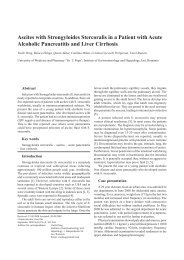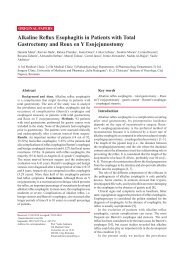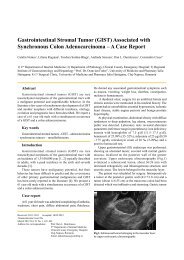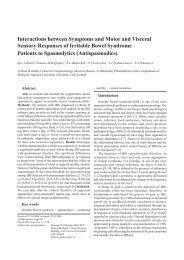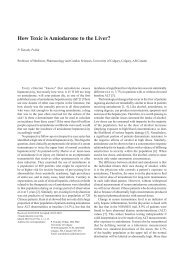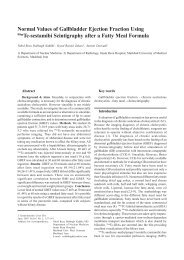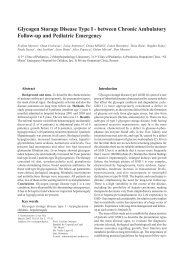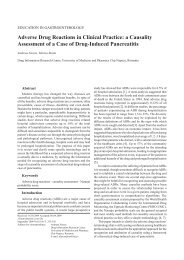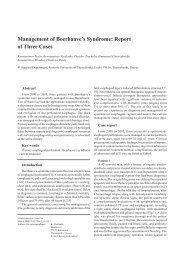Gastric Stromal Tumor: A Rare Cause of Upper ... - ResearchGate
Gastric Stromal Tumor: A Rare Cause of Upper ... - ResearchGate
Gastric Stromal Tumor: A Rare Cause of Upper ... - ResearchGate
Create successful ePaper yourself
Turn your PDF publications into a flip-book with our unique Google optimized e-Paper software.
<strong>Gastric</strong> stromal tumor<br />
<strong>Gastric</strong> <strong>Stromal</strong> <strong>Tumor</strong>: A <strong>Rare</strong> <strong>Cause</strong> <strong>of</strong> <strong>Upper</strong><br />
Gastrointestinal Bleeding<br />
Paula Szanto 1 , Anca Barbus 1 , Nadim Al Hajjar 2 , Teodor Zaharia 3 , Dorina Manciula 4<br />
1) 3 rd Medical Clinic. 2) 3 rd Surgical Clinic, University <strong>of</strong> Medicine and Pharmacy. 3) Department <strong>of</strong> Pathology,<br />
Emergency Clinical Hospital „O.Fodor”, Cluj-Napoca. 4) County Hospital Baia-Mare, Romania<br />
Abstract<br />
Gastrointestinal stromal tumors (GISTs) are a subset <strong>of</strong><br />
gastrointestinal mesenchymal tumors, though relatively rare<br />
in absolute terms. They are characterized by a remarkable<br />
cellular variability and their malignant potential is sometimes<br />
difficult to predict.<br />
We report a case <strong>of</strong> gastric stromal tumor in a 66 year old<br />
patient with a long history <strong>of</strong> anemia and intermitent upper<br />
gastrointestinal bleeding. We performed upper gastrointestinal<br />
endoscopy, biopsy <strong>of</strong> gastric mucosa and<br />
abdominal ultrasonography to establish the diagnosis. The<br />
gastric tumor was successfully resected with a postoperative<br />
favourable outcome.<br />
Key words<br />
Anemia - upper gastrointestinal bleeding - gastric<br />
stromal tumor<br />
Introduction<br />
Gastrointestinal stromal tumors (GISTs) comprise a rare<br />
group <strong>of</strong> neoplasms with unpredictable malignant potential<br />
and an annual incidence <strong>of</strong> 4 / 1 000 000 persons (1). The<br />
stomach is the most common site <strong>of</strong> involvement but GIST<br />
may occur anywhere in the gastrointestinal tract, omentum,<br />
or mesentery (2). <strong>Gastric</strong> stromal tumor is a submucosal tumor<br />
which is different from leiomyoma, leiomyosarcoma and<br />
neurogenic tumors. Immunohisto-chemical study <strong>of</strong> CD117,<br />
the c-kit proto-oncogene product, is a specific marker for<br />
GISTs. Diagnosis <strong>of</strong> this condition is sometimes difficult<br />
and treatment is <strong>of</strong>ten delayed because patients usually<br />
present with nonspecific abdominal symptoms. Abdominal<br />
pain, bloating, upper gastro-intestinal hemorrhage or anemia<br />
may be present. Gastroscopy, endoscopic ultrasound, abdominal<br />
and pelvic imaging are helpful to diagnosis. The final<br />
J Gastrointestin Liver Dis<br />
December 2007 Vol.16 No 4, 441-443<br />
Address for correspondence: Paula Szanto MD<br />
3rd Medical Clinic<br />
Croitorilor str.19-21<br />
Cluj-Napoca, Romania<br />
E-mail: paula_szanto@yahoo.com<br />
diagnosis is decided by pathological and immunohistochemical<br />
examination. The operative treatment is the first<br />
choice, and complete surgical resection is the most definitive<br />
treatment.<br />
Case report<br />
A 66-year old man presented with a four year history <strong>of</strong><br />
abdominal pain, bloating, anemia and two episodes <strong>of</strong><br />
melena which resolved spontaneously. The patient had a<br />
history <strong>of</strong> cardiac disease treated with anticoagulants for<br />
many years. He was admitted in the emergency internal unit<br />
<strong>of</strong> Baia-Mare Hospital with anorexia, weakness, bloating,<br />
melena and anemia. Gastro-scopy revealed an irregular<br />
gastric polyp measuring 3/2 cm, without histological signs<br />
<strong>of</strong> malignancy, and the patient was referred to our<br />
department. The physical examination showed a good<br />
nutritional status and moderate epigastric tenderness. The<br />
haemoglobin level was 9.05 g/dl. A reduced haematocrit<br />
(28.7%) and iron level suggested chronic bleeding. <strong>Upper</strong><br />
digestive endoscopy showed a giant non-pedunculated<br />
polyp (diameter <strong>of</strong> 4 cm) with ulceration <strong>of</strong> the overlying<br />
mucosa, located in the gastric fundus in the proximity <strong>of</strong><br />
cardia. Biopsies were nondiag-nostic. Ultrasound<br />
examination described a hypoechoic, vascularized tumor <strong>of</strong><br />
the cardia (Fig.1).<br />
The patient was referred for surgery. Polar superior<br />
gastrectomy was performed. Macroscopically the tumor was<br />
multinodular (13/10/9 cm), adherent to the stomach, (Fig.2).<br />
Histological examination described a gastric stromal tumor<br />
with free esophageal (superior) and gastric (inferior) margins<br />
(Fig.3). Immunohistochemical markers confirmed the<br />
diagnosis <strong>of</strong> GIST (CD 117 positive, SMA negative, S 100<br />
negative) (Fig.4). The reevaluation, performed 3 and 6<br />
months later, showed complete recovery, without any sign<br />
<strong>of</strong> endoscopic, endosonographic or abdominal CT<br />
recurrence <strong>of</strong> the disease.<br />
Discussion<br />
Gastrointestinal stromal tumors (GISTs), though relatively<br />
rare in absolute terms, are the most common mesen-
442<br />
Szanto et al<br />
Fig.1 Abdominal ultrasound examination showing a<br />
hypoechoic tumor located in the gastric wall.<br />
Fig.3 HE staining suggests a GIST (spindle cell pattern).<br />
Fig.2 Macroscopic view <strong>of</strong> the gastric tumor after<br />
resection.<br />
chymal tumors <strong>of</strong> the gastrointestinal tract (3, 4). The<br />
common sites <strong>of</strong> location are in order the stomach, the small<br />
intestine, the rectum, the esophagus and a small percent<br />
may be located elsewhere in the abdominal cavity (
<strong>Gastric</strong> stromal tumor 443<br />
used to predict their behavior. <strong>Tumor</strong> size and mitotic index<br />
appear to be the most valuable (12). There is reluctance to<br />
use the term „benign” to describe GISTs since this tumor<br />
may be unpredictably malignant. Patients with GISTs may<br />
be categorized into very low, low, intermediate, and highrisk<br />
on the basis <strong>of</strong> an estimation <strong>of</strong> their potential for<br />
recurrence and metastasis (10, 13).<br />
Surgery is the mainstay <strong>of</strong> therapy for GIST when the<br />
primary lesion is deemed resectable. The surgical approach<br />
is to resect the tumor with grossly negative margins and an<br />
intact pseudocapsule. Lymphatic spread <strong>of</strong> GISTs is<br />
uncommon therefore a formal lymph node dissection is not<br />
standard surgical management. Consequently, complete<br />
surgical resection <strong>of</strong> the primary tumor is the most definitive<br />
treatment (1). The tumor must be handled with care to prevent<br />
intra-abdominal rupture and dissemination. <strong>Tumor</strong> rupture<br />
before or during resection is a predictor <strong>of</strong> poor outcome<br />
(14). Formal gastric resection is rarely required as a rule, it is<br />
indicated only for lesions in close proximity to the pylorus<br />
or the esogastric junction.<br />
Prognosis <strong>of</strong> GIST after surgical treatment is influenced<br />
by completness <strong>of</strong> primary resection and tumor malignant<br />
potential. A low grade GIST has an excellent prognosis after<br />
surgery alone, while a high grade GIST has a high rate <strong>of</strong><br />
recurrence after primary resection. Adjuvant treatment<br />
should be advocated for patients with either a high grade<br />
GIST or after incomplete primary surgical treatment. Complete<br />
surgical resection <strong>of</strong>fers a good chance <strong>of</strong> cure for low grade<br />
GIST, while for high grade GISTs surgery alone is not sufficient<br />
(15). The grading system could be used to identify<br />
patients who may benefit <strong>of</strong> adjuvant treatment after GIST<br />
resection.<br />
If the tumor has metastasized or has advanced locally to<br />
the point where surgical therapy would result in excessive<br />
morbidity, the patient is treated with the tyrosine kinase<br />
inhibitor imatinib-mesylate. Imatinib is the standard <strong>of</strong> care<br />
for patients who are not surgical candidates (16). Adjuvant<br />
or neoadjuvant imatinib is not recommended for resectable<br />
nonmetastatic GISTs. Neoadjuvant imatinib may be<br />
considered when surgery would result in significant<br />
morbidity or loss <strong>of</strong> organ function (17).<br />
The evaluation <strong>of</strong> tumor response to therapy on CT<br />
images is based mainly on the World Health Organization<br />
guidelines and the Response Evaluation Criteria in Solid<br />
<strong>Tumor</strong>s (RECIST)(18). Six months after complete surgical<br />
resection our patient has a normal abdominal CT image and<br />
no adjuvant therapy is at the moment indicated.<br />
Long-term follow-up reveals that the majority <strong>of</strong> patients<br />
with GIST tend to recur. The median time to relapse is 18<br />
months, and most recurrences occur within 2 years <strong>of</strong> initial<br />
resection.<br />
References<br />
1. Matthews BD, Joels CS, Kercher KW, Heniford BT. Gastro-<br />
intestinal stromal tumors <strong>of</strong> the stomach. Minerva Chir 2004;<br />
59: 219-231.<br />
2. XThomas A, Sing A. Role <strong>of</strong> positronemission tomographic<br />
imaging in gastrointestinal stromal tumors. Appl Radiol 2005;<br />
34: 10-17.<br />
3. Fletcher CD, Berman JJ, Corless C et al. Diagnosis <strong>of</strong><br />
gastrointestinal stromal tumors: A consensus approach. Hum<br />
Pathol 2002; 33: 459-465.<br />
4. Li J, Liu P, Wang H, Yu J, Xie P, Liu X. Clinical analysis <strong>of</strong> 31<br />
patients with gastric stromal tumors. Zhonghua Nei Ke Za Zhi<br />
2002; 41: 742-745.<br />
5. Brandimarte G, Tursi A, Elisei W, Annunziata V, Monardo E.<br />
Symptomatic gastric leiomyoma mimicking giant gastric polyp:<br />
endoscopic diagnosis and removal. Eur Rev Med Pharmacol Sci<br />
2004; 8: 107-110.<br />
6. Ludwig DJ, Traverso LW. Gut stromal tumors and their clinical<br />
behavior. Am J Surg 1997;173: 390-394.<br />
7. de Silva CM, Reid R. Gastrointestinal stromal tumors (GIST):<br />
C-kit mutations CD117 expression differential diagnosis and<br />
targeted cancer therapy with Imatinib. Pathol Oncol Res 2003;<br />
9: 13-19.<br />
8. DeMatteo RP, Lewis JJ, Leung D, Mudan SS, Woodruff JM,<br />
Brennan MF. Two hundred gastrointestinal stromal tumors:<br />
recurrence patterns and prognostic factors for survival. Ann<br />
Surg 2000; 231: 51-58.<br />
9. Xu GQ, Zhang BL, Li YM et al. Diagnostic value <strong>of</strong> endoscopic<br />
ultrasonography for gastrointestinal leiomyoma. World J<br />
Gastroenterol 2003; 9: 2088-2091.<br />
10. Fujimoto Y, Nakanishi Y, Yoshimura K, Shimoda T.<br />
Clinicopathologic study <strong>of</strong> primary malignant gastrointestinal<br />
stromal tumor <strong>of</strong> the stomach, with special reference to<br />
prognostic factors; analysis <strong>of</strong> results in 140 surgically resected<br />
patients. <strong>Gastric</strong> Cancer 2003; 6: 39-48.<br />
11. Sarlomo-Rikala M, Tsujimura T, Lendahl U, Miettinen M.<br />
Patterns <strong>of</strong> nestin and other intermediate filament expression<br />
distinguish between gastrointestinal stromal tumors,leiomyomas<br />
and schwannomas. APMIS 2002; 110: 499-507.<br />
12. Fletcher CD, Berman JJ, Corless C et al. Diagnosis <strong>of</strong><br />
gastrointestinal stromal tumors: a consensus approach. Int J<br />
Surg Pathol 2002; 10: 81-89.<br />
13. Emory TS, Sobin LH, Lukes L, Lee DH, O’Leary TJ. Prognosis<br />
<strong>of</strong> gastrointestinal smooth-muscle (stromal) tumors:<br />
dependence on anatomic site. Am J Surg Pathol 1999; 23: 82-<br />
87.<br />
14. Bilimoria MM, Holtz DJ, Mirza NQ et al. <strong>Tumor</strong> volume as a<br />
prognostic factor for sarcomatosis. Cancer 2002; 94: 2441-<br />
2446.<br />
15. Bucher P, Egger JF, Gervaz P et al. An audit <strong>of</strong> surgical<br />
management <strong>of</strong> gastrointestinal stromal tumours (GIST). Eur J<br />
Surg Oncol 2006; 32: 310-314.<br />
16. Boggs W. Imatinib improves resectability <strong>of</strong> residual metastatic<br />
GIST disease. Int J Cancer 2005; 117: 316-325.<br />
17. Blackstein ME, Blay JY, Corless C et al. Gastroinestinal stromal<br />
tumours: consensus statement on diagnosis and treatment. Can<br />
J Gastroenterol 2006; 20 (3): 157-163.<br />
18. Antoch G, Kanja J, Bauer S et al. Comparison <strong>of</strong> PET, CT, and<br />
dual-modality PET/CT imaging for monitoring <strong>of</strong> imatinib<br />
(STI571) therapy in patients with gastrointestinal stromal<br />
tumors. J Nucl Med 2004; 45: 357-365.




